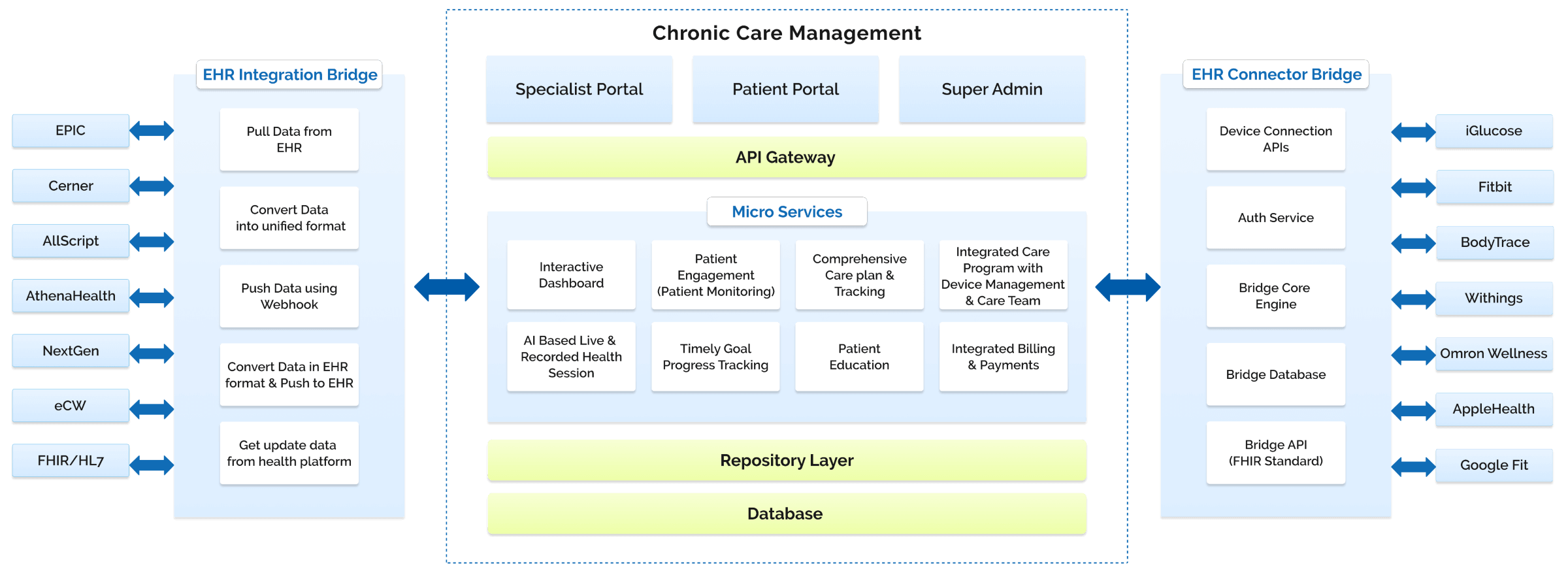Client Requirements
The client was US-based and specialized in web-based technology service providers in the digital healthcare space providing solutions for providers to deliver value-based care to chronically ill patients. The client wants to develop HIPAA-compliant secure chronic care management solutions with telehealth and remote patient monitoring capabilities to maximize the recurring revenue of their valued customers.
Additionally, clients want to make this system interoperable by integrating it with various medical devices, EHRs, and labs to streamline all aspects of health care in one platform.
Thinkitive Solution
Thinkitive’s business analysts and subject matter experts started with the requirement analysis (Discovery) phase. The thinkitive team took multiple calls with the client and created detailed requirement documents and multiple use cases. Thinkitive established a team of professionals with expertise in frontend and backend development.
The Thinkitive builds different microservices utilizing a microservices-based design for each module, such as the patient service, provider service, care management service, video call, two-way messaging, etc. Each service would take care of a particular function of the CCM and interact with the others via clearly defined APIs. A microservice-based design might produce a package management system that is more adaptable, scalable, and maintained.
To interoperability, Thinkitives team of interoperability engineers develop a separate integration bridge for Devices, EHRs, and Labs. The device bridge collects all vital information of the patient and makes it available to providers for review. EHR bridge collects data from multiple EHR from various data standards like FHIR, HL7, and JSON APIs and converts them into unified APIs.To the lab, the interaction system can transfer lab orders and results from and to labs using two-way HL7 messaging.

Solution Highlights
-
End To End Chronic care management software development
The thinkitive team developed an end-to-end Chronic care management platform with the below-listed features.
1. Patient Monitoring: With connected devices and sensors, this capability enables medical professionals to remotely monitor patients with chronic illnesses, including diabetes, heart disease, and hypertension. This aids healthcare professionals in identifying and resolving any problems early on.
2. Care Coordination Using Care Plan:This feature enables healthcare professionals to work together and communicate to ensure patients receive the best treatment possible. It could include exchanging patient data, developing care plans, and assigning work to team members.
3. Medication Management:This function aids in managing and tracking patient medication adherence, including dosage and frequency. Additionally, it might contain alerts for medical professionals if a patient misses a dose of medication and reminders for people to take their prescriptions on schedule.
4. Patient Education:This feature provides information about their condition, treatment options, and self-care strategies. It may include educational resources such as videos, articles, and interactive tools.
5. Remote Consultations:using video calling capability, providers can consult with patients remotely, cutting down on in-person visits and enhancing patient access to care.
6. Analytics and Reporting:Providers can modify care plans and interventions by receiving information about patient health outcomes and trends.
-
Interoperability
1. Device Integration
i. The integration bridge is a mediator between the medical devices and the monitoring platform, enabling the devices to send data in a standardized format.
ii. The integration bridge comprises software modules communicating with the medical devices and the monitoring platform using standardized protocols. These protocols may include Bluetooth, WiFi, cellular data, or other communication methods.
iii. The integration bridge can support various medical devices, including blood pressure monitors, glucose meters, pulse oximeters, weight scales, and other monitoring devices.
2. EHR Integration Bridge
i. The integration bridge for CCM typically works by automatically syncing patient data from the EHR system to the CCM software, allowing care managers to quickly access patient information, create care plans, and track patient progress.
ii. This integration also allows care managers to document their work in the EHR system, reducing the need for duplicate data entry and improving documentation accuracy.
3. Lab Integration
i. Our team has developed a lab integration system enabling uni or bi-directional communication between labs and the provider's office using HL7 messaging. It allows transferring lab orders and results uploaded by lab practitioners.
Value Delivered
-
Enabled healthcare providers to identify and address population health trends and risk factors, helping to prevent chronic conditions from developing in the first place.
-
This platform reduces healthcare costs by preventing hospital readmissions, reducing emergency room visits, and promoting preventative care.
-
By managing chronic conditions more effectively, healthcare providers can also reduce the need for costly interventions and procedures.
-
CCM programs involve regular communication between healthcare providers and patients, which can improve patient-provider relationships and enhance communication and understanding about treatment plans and goals.